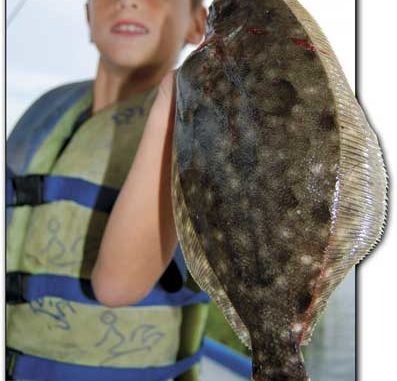
This bridge is like a 24-mile artificial reef that’s holding oodles of speckled trout right now.
In Louisiana, flounders are enormously popular food and sport fish. Although 18 species of the lefteye flounder family are found in the northern Gulf of Mexico, “flounder” in Louisiana almost invariably means the southern flounder. Its Latin name, Paralichthys lethosigma, literally means “parallel fish that forgot its spots.”In Louisiana, southern flounder can be found from 100 miles up the Mississippi River in pure fresh water out to full-strength seawater well off the coast, although most studies show that they are most common at moderate salinities.
Most research indicates that male flounders stay in offshore waters year-round. Male flounders are small, seldom larger than 10 to 12 inches, but females grow larger and move longer distances. Females may reach 23 inches long, and spend most of the year in inshore waters, only migrating offshore during the October to December spawning period. Excellent catches of flounder can be made during this time.
Female southern flounders spawn several times during this annual spawning period, producing about 100,000 eggs each spawn. Spawning seems to be triggered by water temperatures of about 56 degrees, and usually occurs between 5 and 9 a.m.
After hatching, larval southern flounders grow most rapidly in highly saline waters. Young flounders begin to appear in Louisiana inshore estuaries between January and April, and range 1/4 to 2 inches in length. Like other fish, flounders hatch with one eye on each side of the head. Movement of the right eye to the left side of the head begins when the fish is 1/3- to 1/2-inch long, and is complete when the fish is 3/4- to 1-inch long. At this same time, the left side develops its dark color and the right side turns white.
After hatching, southern flounder larvae eat microscopic floating animals (plankton). As juvenile fish, they eat small bottom animals. Then, at about 6 inches long, they adopt their adult diet of fish, with over 40 percent being anchovies, commonly called “sardines” by fishermen. In Barataria Bay, one study showed that 94 percent of their diet consisted of mullets and anchovies.
In Texas, researchers have noted that the southern flounder is the dominant predator of shrimp in the spring, and that most of its diet consists of anchovies, mullets, shrimp, menhaden (pogies) and croakers. In Mississippi, southern flounders’ stomachs most frequently contained fish, although one-third had shrimp in them. Interestingly, as flounders get larger, they don’t eat larger fish, they just eat more small ones.
Female southern flounders grow more rapidly than males. A research project in Louisiana did not find a male southern flounder over 13.5 inches long. Another study in Georgia showed no males larger than 16 inches long, and research in Texas showed no males over 12.8 inches long.
Female flounders grow quickly during their first two years; then growth slows. Average lengths by age for females are: age 1, 10 inches; age 2, 16.7 inches; age 3, 18.8 inches; age 4, 19.6 inches; age 5, 20 inches; age 6, 20.4 inches and age 7, 20.5 inches. Few females live beyond seven years old, and almost no males live past three years old.
Flounders are considered ambush predators. Instead of actively pursuing their prey, they lie in wait in areas that are likely to concentrate or disorient small fish or shrimp. From their position on the bottom, flounders pounce on these animals as they move by.
Because of their feeding habits, large numbers of flounders will concentrate in good ambush areas. Especially productive are current-swept points and channels that serve as choke points for tidal currents.
Southern flounder take live bait, jigs, or even spoons that are fished near the bottom. Because their mouths open side-to-side, rather than vertically, small hooks will produce more hook-ups than large hooks.
Flounders may also be gigged with a one-pronged spear in shallow waters at night by fishermen using lanterns for illumination. Firm sandy bottoms are preferred for easy wading. Gigging is most successfully conducted on a rising tide and in clear water. The largest flounders are almost invariably gigged in October and November near Louisiana’s barrier islands, as the larger females appear to congregate in these waters during their spawning migration to offshore waters.
Currently, the daily recreational limit on southern flounder is 10 per day. The possession limit (on land) is 10 per day per licensed person for each consecutive day spent on the water. There is no minimum size limit on southern flounder in Louisiana.
Jerald Horst is co-author of Angler’s Guide to Fishes of the Gulf of Mexico, a 444-page, color-illustrated book on fishes, written for saltwater fishermen. The book is available in better bookstores, or can be ordered by calling 800-843-1724.


